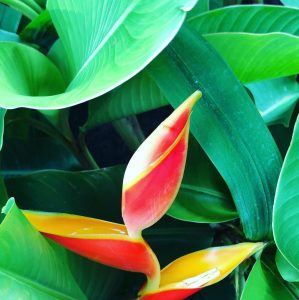
Tamarind seedling emerging with secondary leaves.
Difficulty:
Moderate (not for the complete novice gardener, but if you have raised other plants from seed and live in a warm climate you should give this a go).
What you will need:
- Fresh tamarind seeds
- 1 small cocopeat brick
- Bag of good quality seed raising mix
- 100mm pots (preferably taller than they are wide)
- A large saucer to hold around 1 cm of water
- A protected place, with some partial morning sun
Seeds are an excellent way to expand your plant collection for very little cost. You have a much wider variety of plants available to you if you can master the skill of growing plants from seed. You just need patience, persistence and an understanding of the plant you are growing.
I have so far raised several types of plants from seed this year, most successfully but I have also had a few failures. The good thing about growing seeds is that they are generally cheap, so if you do fail it won’t break the bank. But when you succeed, you feel very accomplished and there is nothing more fulfilling than creating new life.
Tamarind has been something I have been interested in growing since I was last in India, and it is just everywhere in Indian cuisine. I have had the most delicious spicy tamarind biriyani, curries, and tamarind chutney. It adds an interesting sour flavour to dishes. This is also particularly useful in Thai cooking where there is interplay between sweet, salty, and sour – tamarind and lime providing the sour component of the dish. It would be impossible to make Pad Thai and Massaman curry, for example, without Tamarind’s unique sourness.
There are generally two type of tamarind pulp commercially available in jars – one is sweet and the other sour. Most of the time, the sour version is used in cooking for the reasons I mentioned above. If you growing tamarind from seed, you will not know what quality or sourness the fruit will have until approximately 7 years later when it bears its first fruit. I am OK with not knowing what my tamarind will taste like in 7 years time – for me, this is all part of the surprise of growing from seed.
If you are after a particular tamarind that has the same fruit as it’s parent plant, you are better off propagating this from cuttings as you will get a clone of the original tree and the new plant will produce fruit sooner than a plant grown from seed.
Wait till the warmer part of the year to grow tamarind from seed – in Brisbane the best time to sow tamarind seed is from October onwards when we begin to have consistently warm weather and fewer dry winds.
I bought 12 seeds for less than $5 including postage from a seller on eBay (the seller is based in Queensland), which were advertised as harvested this year – the fresher, the better as your germination success rate will be higher. I started by soaking half (6 of them) in lukewarm water for 2 days. In this time, 2 of the seeds appear to ‘explode’ in the water which is usually a good thing as this is the hard outer shell of the seed separating from the main part of the seed which can lead to faster germination.
After these seeds were soaked, I half-filled 100mm pots with rehydrated cocopeat. The seed raising mix is quite expensive and cocopeat has excellent moisture holding properties – it is a low cost renewable garden product will myriad uses (I make my own potting mix using a mixture of cocopeat, compost, and a few other ingredients).

100 mm pots work best, as they don’t dry out as quickly as smaller containers.
I then topped up the pot with the seed raising mix about an 3 cm from the top, where I placed the tamarind seeds and topped off with more seed raising mix.
I have my seed raising pots in a purpose built shade house on an east-facing brick wall, where it only gets some direct morning sun for about half an hour and for the rest of the day it is warm, protected, but shaded. I placed the pots in a saucer of water – the idea being that the cocopeat will wick up the water and keep the seed raising mix evenly moist. I also choose 100mm pots as these have less chance of drying out.

Our mini greenhouse, converted into a shade house for raising seeds and tender plants.
Wait a few weeks, making sure that the pots are kept moist and the water is topped up each day. You may need to be patient with tamarind as the seeds are quite hard, so it can take a while to germinate.
Once the seedling starts to develop its second set of leaves, you can take it out of the saucer of water as tamarinds hate wet feet. Allow to dry out between watering, but in the early stages it is important to water regularly. If the soil feels almost dry to the touch, it is time to water again.
Growth should be vigorous in the first year, but will slow down after that. I hear that you can grow tamarind quite successfully in containers, which is what I intend to do as I don’t have any room for a large tree in my garden. It also makes an excellent bonsai specimen. It is a slow-growing, long-lived legume that will probably outlive you – so if you do plant it in the garden, allow room for it to grow and don’t plant too close to any structures.
Otherwise, enjoy what this fascinating, attractive, and versatile tree has to offer in the garden – and in a few years you will be enjoying tamarind fruit fresh off the tree.
Happy gardening!
